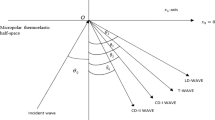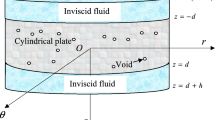Abstract
A mathematical model of the disturbance of the stationary geothermal field due to a three-dimensional perturbing body embedded near the surface of a two layered earth. The theoretical analysis is based on the generalized theory of the double-layer potential, similar to the boundary integral method likely to direct current geoelectricity problems. Special attention is paid to cases in which a pan of the body's surface is tangential to the planar boundaries of the substratum or of the surface of the earth The numerical calculations are performed for a three-dimensional prism using methods similar to the boundary element method (BEM). Numerous graphs are shown for the disturbance of the temperature field and of the heat flow on the surface of the earth and along vertical profiles (boreholes).
Similar content being viewed by others
References
Brebbia C.A., Telles J.C.F., Wrobel L.C., 1984: Boundary element techniques, Springer Verlag, Berlin.
Carslaw H.S., Jaeger J.C., 1959: Conduction of heat in solids. Claredon Press, Oxford.
Čermák V., 1977: Geothermal models of the Bohemian Massif (Variscan) and the Western Carpathians (Alpine) and their mutual relation. Tectonophys., 41, 127–137.
Chen Y., Beck A.E., 1991: Application of the boundary element method to a terrestrial heat flow problem. Geophys. J. Int., 107, 25–35.
Dwight H.B., 1961: Tables of integrals and other mathematical data. McMillan, New York.
Hvoždara M., 1982: Potential field of a stationary electric current in a stratified medium with a three-dimensional perturbing body. Studia geophys. geodaet, 26, 160–172.
Hvoždara M., 1995: The boundary integral calculation of the D.C. geoelectric field due to a point current source on the surface of 2-layered earth with a 3-D perturbing body, buried or outcropping. Contribut. Geophys. Inst. Slov. Acad. Sci., 25, 7–25.
Ljubimova E.A., Ljuboschits V.M., Parfenyuk O.I., 1983: Numerical model of temperature fields in the Earth. (in Russian), Nauka, Moskva.
Majcin D., 1988: Conputation of the temperature distribution along the DSS profiles running through Slovakia. Contribut. Geophys. Inst. Slov. Acad. Sci., 18, 38–57.
Spitzer K., 1995: A 3-D finite-difference algorithm for D.C. resistivity modelling using conjugate gradient methods. Geophys. J. Intern. 123, 903–914.
Rights and permissions
About this article
Cite this article
Hvoždara, M., Valkovič, L. Refraction Effect in Geothermal Heat Flow Due to a 3-D Prism in a Two-Layered Earth. Studia Geophysica et Geodaetica 43, 407–426 (1999). https://doi.org/10.1023/A:1023287203308
Published:
Issue Date:
DOI: https://doi.org/10.1023/A:1023287203308




